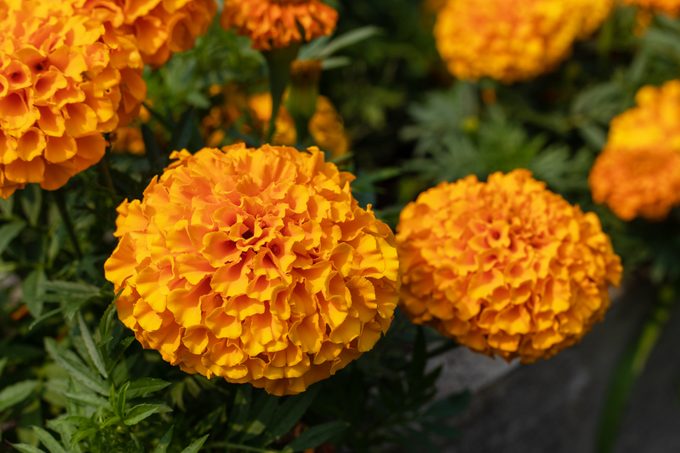

If you want a flower to evoke a memory, choose a scented one. Marigolds, with their distinctive scent, always remind me of being a kid and helping my dad sow seeds for marigolds and other annual flowers in our garden.
On This Page
Types of Marigolds
There are several types easily grown from seed. All are in the plant genus Tagetes.
French marigolds
French marigolds, Tagetes patula, are smaller plants with fern-like foliage. Varieties such as ‘Cottage Red‘, ‘Jaguar‘ and ‘Bolero‘ generally grow from eight to 12 inches tall and flower freely from summer through fall, until the first frost.
African marigolds
African marigolds, Tagetes erecta, are larger than French marigolds. Some varieties,such as ‘Crackerjack‘ grow as tall as three feet. Flower colors range from yellow to orange. There are also white-flowering varieties, including ‘Kilimanjaro White.‘ Occasionally, African marigolds are also called American or Aztec marigolds.
Signet marigolds
Signet marigolds, Tagetes tenuifolia, are annual herbs with edible flowers. Varieties of signet marigolds including ‘Lemon Gem’ and ‘Tangerine Gem.’ Signet marigolds are smaller plants, generally not exceeding one foot tall.
Hybrid marigolds
Hybrid marigolds, sometimes called triploid marigolds, are crosses between French and African marigolds. These tend to be stronger plants, often with double flowers. ‘Primrose Lady’ and ‘Snowball’, which has white flowers, are hybrid varieties. (Both were out of stock at the online retailers we checked.)
How To Plant Marigold Seeds
Marigolds are all easily grown from seeds, sown directly in the garden or indoors six to eight weeks before your spring frost-free date. All marigolds prefer a sunny location with good, well-drained garden soil.
How to plant marigold seeds indoors
- Fill small pots with a seed starting mix. Biodegradable pots in a plastic seed starting flat are ideal.
- Sow three to four seeds in each pot, about 1/4-inch deep.
- Water well and cover with clear plastic to keep seed starting mix from drying out. Place under grow lights or near a bright south-facing window.
- Once seeds have germinated, remove the plastic cover and continue to water so the seedlings don’t dry out.
- Before planting in the garden, “harden off” the seedlings by placing them outside a few hours a day when days are warmer and there’s no possibility of frost.
How to plant marigold seeds directly in the garden
- A few weeks after your last frost, lightly till the soil where you plan to grow the marigolds.
- Sow seeds about 1/4-in. deep.
- To determine how far apart to space seeds, check the instructions on the seed packet. Smaller varieties can be grown closer together.
- Water the area and keep watered until seedlings emerge, which can be as soon as one week.
- Once seedlings have germinated, thin out to the proper spacing as directed on the seed packet.
When to Plant Marigold Seeds
Marigolds are warm-season annuals that do not tolerate frost. So plant them in your garden when you are sure it’s frost-free in the spring and the soil has warmed. This can be as early as mid-February in places like New Orleans, and almost June 1 in Northern locations like Duluth, Minn. Once growing, marigolds will continue to bloom until the first frost of fall.
How to Care for Marigold Plants

Watering
Marigolds should be kept watered until established and blooming. At that point, they need an inch of water a week, from rainfall or hand watering.
Fertilizing
In most gardens, marigolds do not need additional fertilizer. If you’re not sure how fertile your soil is, add an all-purpose garden fertilizer when you plant.
Staking
Some larger marigolds, such as hybrids and African marigolds, may need to be staked. Plan ahead by setting stakes in the ground before you need them. You can use simple stakes with twine or metal plant supports.
Pruning
To keep your marigolds blooming throughout the summer and into fall, remove old flowers once they’ve faded and before they set seed. You can usually snap them off or cut them with small hand pruners or snips.
Controlling pests
There are a few pests and plant diseases that can attack marigolds. Giving the marigolds adequate room goes a long way toward avoiding these problems, along with keeping the plants well-watered.
If you notice aphids or spider mites, try spraying the marigolds with a strong water spray, hitting the undersides of the leaves to wash away the pests. Often this is enough to save your marigolds.
Plant disease symptoms vary, but could include stunted growth or grayish leaves. If you notice what you think is plant disease, your best option may be to pull up the infected plants and toss them in the trash. Then make a note to plant something other than marigolds in that spot the following year.
Did you miss our previous article…
https://tophouseimprovement.com/how-to/fire-hazard-leads-to-the-recall-of-more-than-one-million-boxes/
